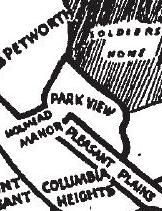
Map showing where DC's population is concentrated by Ward based on 2010 census data
After many months of waiting, the 2010 census results for the District of Columbia were finally released yesterday. Perhaps the most surprising thing for anyone familiar with the data in the recently released American Community Survey (ACS), despite the ACS’s indication that Ward 1 was the only ward to decrease in population, the 2010 census in fact shows a healthy growth in Ward 1 and a decrease in population in Ward 8. Ward 1 increased by 2,833 residents and Ward 8 lost 215 residents.
Closer to home, census tract 32, which encompasses all of Park View east of Georgia Avenue, increased to 4,913 from 4,480. This is a 9.7% increase in population and brings the number of residents in Park View to a level not seen in over 20 years.
Now that the numbers are in, the redistricting process can begin. As we learned in late December 2010, DC’s population grew from 572,059 in the 2000 census to 601,723, an increase of 29,664 residents. In an ideal world, each of the District’s 8 wards are supposed to have roughly the same population, making the average ward size 75,215 people.
The redistricting law requires each ward to be within 5% of the average. That means a ward could be as large as 78,796 people or as small as 71,455. In looking at the data released yesterday, the populations by ward are currently:
- Ward 1 — 76,197 (+1.30%)
- Ward 2 — 79,915 (+6.25%)
- Ward 3 — 77,152 (+2.58%)
- Ward 4 — 75,773 (+0.74%)
- Ward 5 — 74,308 (-1.21%)
- Ward 6 — 76,598 (+1.84%)
- Ward 7 — 71,068 (-5.52%)
- Ward 8 — 70,712 (-5.99%)
A quick review of the population data shows that three wards are outside of the 5% allowable variance — Ward 2 (which is over) and Wards 7 & 8 (which are below). The map below quickly shows the Wards needing to be adjusted (in orange).

Map showing DC Wards not within 5% of the average in orange
What isn’t clear yet is how the new ward lines will be drawn. Wards 7 & 8 need to grow in population and area while Ward 2 needs to shrink in both population and size … but these three wards aren’t contiguous (in that 7 and 2 don’t share a border). While I can come up with a scenario that leaves the boundaries of Wards 1, 3, 4, & 5 as they are, I think Ward 6 is going to have to be in play to bring Ward 7 within the 5% variance.
And if redistricting the Wards isn’t enough fun, once that is set the Advisory Neighborhood Commission boundaries will need to be similarly adjusted.










 "The territory comprising Park View extends from Gresham Street north to Rock Creek Church Road, and from Georgia Avenue to the Soldiers' Home grounds, including the triangle bounded by Park Road, Georgia Avenue, and New Hampshire Avenue" (from Directory and History of Park View, 1921.)
"The territory comprising Park View extends from Gresham Street north to Rock Creek Church Road, and from Georgia Avenue to the Soldiers' Home grounds, including the triangle bounded by Park Road, Georgia Avenue, and New Hampshire Avenue" (from Directory and History of Park View, 1921.)
